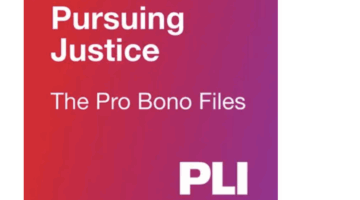 There has been a big brouhaha over a recent a New York federal district court summary judgment ruling that held embedding a tweet on a web page constitutes copyright infringement. Yes, you read that correctly — the judge presiding over Goldman v. Breitbart, Judge Katherine B. Forrest, essentially disregarded years of copyright jurisprudence that stands for the proposition that displaying copyrighted content within a web page that is linked from another’s server is not copyright infringement. Although many news outlets and commentators are criticizing the decision, I understand and appreciate Judge Forrest’s interpretation of the Copyright Act (more on that later) and feel that some of the criticism is unwarranted. In fact, there is a lot of exaggeration and hyperbole out there regarding this summary judgment decision. That said, the online copyright landscape is changing and it is high time that web users start “rethinking linking.”
There has been a big brouhaha over a recent a New York federal district court summary judgment ruling that held embedding a tweet on a web page constitutes copyright infringement. Yes, you read that correctly — the judge presiding over Goldman v. Breitbart, Judge Katherine B. Forrest, essentially disregarded years of copyright jurisprudence that stands for the proposition that displaying copyrighted content within a web page that is linked from another’s server is not copyright infringement. Although many news outlets and commentators are criticizing the decision, I understand and appreciate Judge Forrest’s interpretation of the Copyright Act (more on that later) and feel that some of the criticism is unwarranted. In fact, there is a lot of exaggeration and hyperbole out there regarding this summary judgment decision. That said, the online copyright landscape is changing and it is high time that web users start “rethinking linking.”
This ruling stems from a photograph taken by the photographer Justin Goldman in 2016 depicting the quarterback for the New England Patriots (Tom Brady) and the general manager for the Boston Celtics (former NBA All-Star and champion Danny Ainge) in East Hampton, NY, that appeared to foment rumors of recruiting Kevin Durant (an All-Star basketball player for the Golden State Warriors). Mr. Goldman uploaded the image to his Snapchat Story, but once posted, the image apparently went “viral” on social media and eventually ended up on Twitter, being uploaded by some users into some tweets. A number of news websites then embedded tweets containing the photo into stories about the potential recruitment of Kevin Durant by the Celtics posted in their online publications. Goldman later sued the online publications for copyright infringement, claiming unauthorized use of the photo. What is important to understand is that none of the defendant publications copied and saved the photo into their servers — they only embedded the tweet that contained the photo.
The reason for the big link stink is that there has been some authority for at least the last 10 years that established that inline linking to (or embedding of) content located on other websites does not constitute copyright infringement. This “server test” has been relied upon by news outlets as a defense against infringement, leading them to embed third-party hosted content without fear of infringement liability. What makes Judge Forrest’s position interesting is that she took a more narrow reading of precedent, finding that there is no support in the text or legislative history of the Copyright Act to justify such reliance on the location of the copyrighted work as determinative of infringement. In fact, Judge Forrest stressed that “technical distinctions invisible to the user should not be the lynchpin upon which copyright liability lies” (relying on the Supreme Court’s decision in American Broadcasting Companies v. Aereo), casting aside prior jurisprudence that she asserts relied on a distinction that should have no bearing on whether the exclusive right to display the work under copyright law is infringed.

Pursuing The Pro Bono Story: A Conversation With Alicia Aiken
This Pro Bono Week, get inspired to give back with PLI’s Pursuing Justice: The Pro Bono Files, a one-of-a-kind podcast hosted by Alicia Aiken.
So, what does this mean? What are online news publications, bloggers, and other websites embedding content to do? Well, it’s not time to panic. In fact, here are 3 big reasons why it’s not the end of the online world:
1. Deep Linking is NOT Affected. Everyone is reacting to this deviation from precedent, but everyone needs to take a breath. The summary judgement holding addresses the inline linking or “embedding” of content directly into a web page, not deep linking (i.e., a hyperlink to offsite content that actually brings you to a page on another website other than the homepage). Deep links are unaffected by this ruling, as the user is redirected to the offsite content with such links (as opposed to viewing it framed within a web page). Deep linking is alive and well on the internet, and will stay that way after this ruling.
2. Private Posting, NOT a Public One. This is an important point, and one that has been stressed by the plaintiff’s counsel in the case — the photo was posted to a private group and was never intended for public dissemination. If Goldman had posted his picture in a tweet on Twitter, he would have difficulty claiming infringement when the terms of use for Twitter (as with other social media sites) permit the use of the image and its republication. Although such terms also require the user to aver to ownership of such images (or sufficient rights to them), the point here is that legitimate issues of placement in the public domain remain to be resolved.
3. You Still Have a TON of Other Defenses. Judge Forrest was very clear on this point: despite the finding of infringement, there are “a number of as yet unresolved strong defenses to liability” that are available. For one, fair use is a very viable defense available to news publications embedding such tweets. There is also a defense under the Digital Millennium Copyright Act (specifically, Section 512(c) “safe harbor”) as well as the “innocent infringer” defense. These are legitimate defenses, and with respect to fair use, a potentially successful one for the defendants in the Goldman case.

The Trump Gold Card: A New $1 Million Pathway To A U.S. Green Card
A new proposal would let wealthy foreign nationals secure an opportunity for a U.S. green card with a $1 million 'gift' to the government, sparking legal and ethical debate.
As you can see, the asserted apocalypse from this ruling is definitely exaggerated; however, it cannot be discounted. News publishers will need to be more careful with embedding tweets, images, or other content, and the scope and extent to which this will need to be done has yet to be seen. Although it is unclear whether this ruling will become a lynchpin upon which future interpretation of inline linking and the Copyright Act will be based, the ruling simply cannot be ignored. That said, legitimate defenses to use of such works remain available. There may be some rethinking about linking going forward, but no worries — the internet will not be broken down as a result.
 Tom Kulik is an Intellectual Property & Information Technology Partner at the Dallas-based law firm of Scheef & Stone, LLP. In private practice for over 20 years, Tom is a sought-after technology lawyer who uses his industry experience as a former computer systems engineer to creatively counsel and help his clients navigate the complexities of law and technology in their business. News outlets reach out to Tom for his insight, and he has been quoted by national media organizations. Get in touch with Tom on Twitter (@LegalIntangibls) or Facebook (www.facebook.com/technologylawyer), or contact him directly at [email protected].
Tom Kulik is an Intellectual Property & Information Technology Partner at the Dallas-based law firm of Scheef & Stone, LLP. In private practice for over 20 years, Tom is a sought-after technology lawyer who uses his industry experience as a former computer systems engineer to creatively counsel and help his clients navigate the complexities of law and technology in their business. News outlets reach out to Tom for his insight, and he has been quoted by national media organizations. Get in touch with Tom on Twitter (@LegalIntangibls) or Facebook (www.facebook.com/technologylawyer), or contact him directly at [email protected].